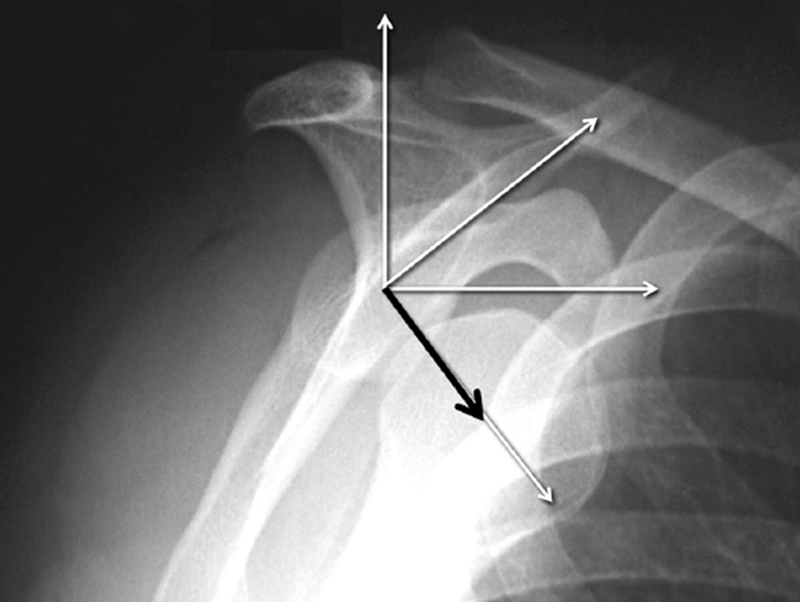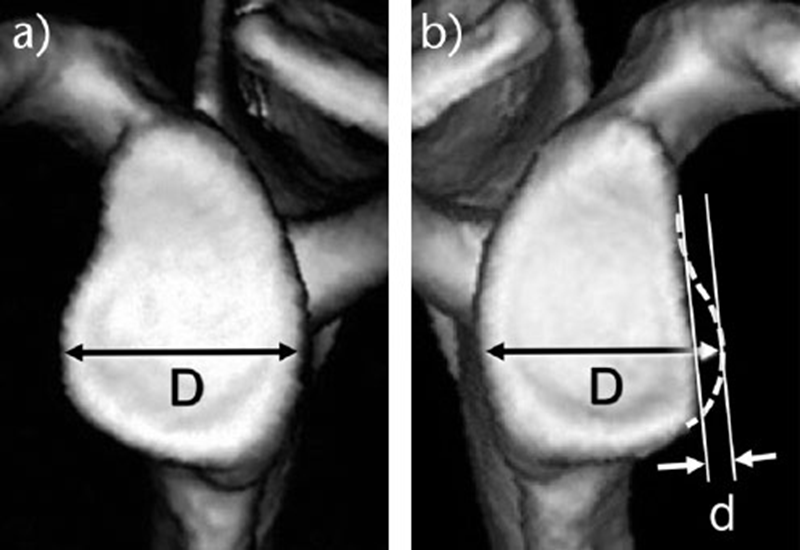肩关节脱位是最常见的关节脱位,当第一次脱位时,医生给予手法复位,一段时间后往往再次出现,形成复发性脱位。频繁的脱位往往导致关节盂和肱骨头的撞击,骨与骨的撞击会带来两败俱伤的结果,肩胛盂的骨缺损,又称为骨性Bankart损伤。

肩关节脱位大都是前下脱位,但相对于肩胛盂来说是往前方脱位。

在4:30钟位逐步形成前下部骨缺损。
目前评估关节盂骨缺损的方法很多,如X线片、CT、3DCT、MRI和关节镜。使用3DCT的“en face”切面法是最被认可,因为它提供了对关节盂骨缺损最准确的评估。
如何估计原始的关节盂形状?有以下两种方法。

①“最佳拟合圆”法。应用了一个最适合的圆圈,它完美地适合于关节盂的后部和下部。这个圆圈被认为接近关节盂的原始形状。

②对侧法:对侧肩(A),如果完好无损,可作为对照(虚线)(B)。
以上两种方法均可作为估算原始关节盂的形态。
关节盂缺损的程度用什么方法表达呢?有面积测量和线性测量两种方法,目前主流应用的是面积测量法,以后文章会讲到轨道上/轨道外(On-track and of-track)的概念,也是应用这种方法测量缺损的。

线形测量:a)对侧关节盂,完好无损。D代表完整的肩胛盂的宽度;
b)患侧的肩胛盂骨质缺损。D来自完整侧,完整的肾盂宽度D与缺损的肾盂宽度之间的差值为缺损宽度d。缺陷的大小表示为d/D×100(%)。
参考文献:
1.Itoi,E.(2017).On-track' and 'off-track'shoulder lesions.EFORT Open Reviews,2(8),343-351.doi:10.1302/2058-5241.2.170007
2.Provencher Mt,Bhatia s,ghodadrans,et al. Recurrentshoulder instability:currentconcepts for evaluationand management of glenoid bone loss.JBone Joint Surg[Am]2010;92-A:133-151
3.Bishop JY,Jones gl,rerkoMa,donaldson C.3-D CT is the mostreliable imaging modalitywhenquantifying glenoid bone loss.Clin Orthop Relat Res 2013;471:1251-1256.
4.Huijsmans PE,Haen Ps,Kidd M,et al. Quantification of a glenoid defectwith three-dimensional computedtomography and magneti resonanceimaging:a cadaveric study.J Shoulder Elbow Surg 2007;16:803-809
5.sugaya H,Moriishi J,dohi M,Kon Y,tsuchiya a.Glenoid rim morphologyin recurrent anterior glenohumeralinstability.J Bone Joint Surg Am] 2003;85-A:878-884.
6.Huiismans PE,de Witte PB,de VilliersrV,et al.Recurrent anterior shoulderinstability:accuracy of estimations ofglenoid bone loss with computedtomography isinsufficientfortherapeutic decision-making.Skeletal Radiol 2011;40:1329-1334.
7.griffith JF,antonio gE,tong CW,Ming CK. Anterior shoulder dislocation:quantification of glenoidbone losswithCT.AJR Am J Roentgenol2003;180:1423-1430.
8.di giacomo g,itoi E,Burkhart sSS. Evolving concept of bipolar bone lossand the Hill-Sachs lesion:from "engaging/non-engaging lesion to “on-track/of-track'lesion.Arthroscopy 2014;30:90-98